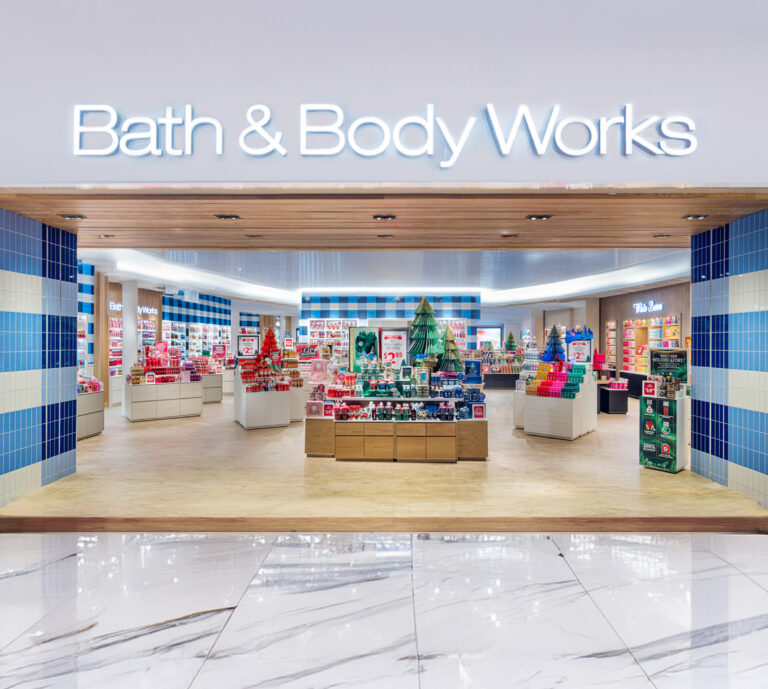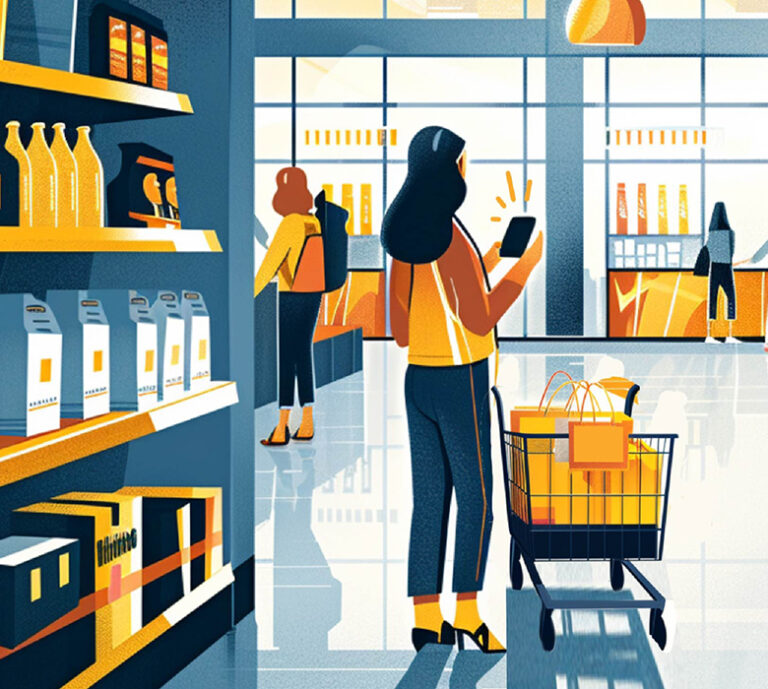×

Our Executive Director of Architecture, Glen Middleton, shares how brands should be approaching sustainable retail design.

Lynn Gonsior, Partner & COO, talks to Connie Gentry for the cover story in Chain Store Age about the year ahead for brick and mortar retail.
Accelerated adoption. That’s how industry analysts describe 2020’s integration of brick-and-mortar with online sales. Multi-year plans to transition offline and online into an omnichannel presence came to fruition in a matter of months, a momentum born of necessity that effectively positioned retailers that ‘got it’ to enter 2021 poised for reinvention.
“Something positive coming out of COVID-19 is that retailers finally understand omnichannel is about functioning as one; you can’t think about the online business and physical store as two [entities],” said Lynn Gonsior, partner and COO of retail brand experience and design firm ChangeUp. “Retailers are thinking more holistically about the customer journey and how they have to deliver consistently across both online and offline.”
For years, the talk has been about giving consumers what they want, where they want it. That hasn’t changed. But what few saw coming was that the “where” might be curbside — a trend that speaks to the intrinsic value of having a brick-and-mortar foundation to support online sales.
“We’ve all had a lesson in improv during COVID,” Gonsior added. “There’s more of a mindset for experimentation, and more integration across channels. We’re seeing more retailers do a better job around curbside service.”
Craig Johnson, president of Customer Growth Partners, noted that online sales were 18% of total retail sales in 2019, a measure that would typically increase about 1 point a year.
“At the peak of COVID closures this year, the online penetration went from 18% to 26%,” he said. “Since then there’s been a little bit of a ratchet factor so it tucked back to around 24 or 25%. What that means is we’ve packed six years of growth in online penetration into six months elapsed time. It’s a sea change; and now omnichannel is a must-have — it’s like table stakes just to get in the game.”
With regard to 2021, Johnson said brick-and-mortar retailers must do three things: optimize online, gain a better understanding of their customers’ needs and preferences and “right-size their store fleets.”
“A lot of retailers were over capacity,” he said.
“They have too much retail square feet facing too few customer feet. And a lot of retailers, particularly apparel and department stores, have been in denial about being over capacity versus demand.”
Johnson’s advice: Unless you are expanding into a new geographic area, concentrate growth on the online side and increase productivity through an omnichannel hybrid.
“Look at Home Depot, they haven’t expanded in the U.S. in the last couple of years,” he said. “Their growth comes from increased productivity at its existing stores and migrating customers to online or that hybrid model [where customers buy online and pick-up at the store].”
What hasn’t changed is the real estate that is at greatest risk of failing: B and C malls around the country, populated with weak tenants and department stores that are struggling.
“The idea of a cookie-cutter format will go away this year. We need to be more flexible in how we think about what stores are, how they service the consumer, and how they deliver a meaningful experience.”
In its Predictions 2021: Retail report, Forrester predicts that the savviest mall operators will see a renaissance in 2021 — but with new business models and purpose in place.
“We predict mall operators will change tenant fee agreements to include online sales that involve in-mall fulfillment, such as “buy online, pick-up in-store,” on top of traditional in-store sales,” the report stated. “And mall operators will attempt to take more control of their destinies (and the customers’ mall experience) by acquiring parts of their tenant portfolio, such as Simon Property Group and partners buying mall stalwarts such as Brooks Brothers and Forever 21.” (At press time, a U.S. bankruptcy court approved the sale of J.C. Penney to Simon and Brookfield.)
“This is a forced right-sizing,” Johnson added. “Although painful, the industry will emerge much healthier and more flexible than in the past. In its own crazy way, this will have a pretty positive outcome.”
Ethan Chernofsky, VP of marketing at Placer Labs, is also optimistic about brick-and-mortar retail in 2021, and about the concept of right-sizing.
“As brands are able to look at data sources and understand where audiences are coming from, they can right-size intelligently,” he said. “Just cutting stores can hurt the situation and not solve the problem. Walmart closed two supercenters last year, not because they were underperforming but because they could serve the same customers from other stores. That is what right-sizing is all about: How you serve as much of your audience as possible with as few stores and as little cost as possible.”
Another critical aspect of right-sizing is footprint optimization within the box, a move to efficiency that ideally is tailored to meet the unique expectations of consumers in each market.
“The idea of a cookie cutter [format] will go away this year,” Gonsior predicted. “We need to be more flexible in how we think about what stores are, how they service the consumer, and how they deliver a meaningful experience.”
Finding balance is going to be critical, according to Gonsior. Retailers need to look at a store’s square footage and consider proportions of the front of house and back of house.
“If a store functions as a distribution center because the retailer is making deliveries to local customers or doing curbside pick-up, maybe the footprint where people shop is smaller and more spaces is dedicated to the back of house,” she said.
Right-sizing applies to product assortment and inventory control as well.
Antony Karbus, CEO, HRC Retail Advisory, predicts 2021 will be “incredibly uneven, with a huge polarization between the winners and the losers.”
“The big difference is that the winners will have very strong omnichannel capabilities,” Karbus said. “Winners will also have very strong inventory management capabilities and create a reason for people to come to the store, whether it’s a treasure hunt or fresh new merchandise. You can’t have stale goods in your store and think people will come, because they won’t.”
Karabus cited Dillard’s as having done a good job refreshing its inventory..
“The did massive markdowns in the second quarter to clean out inventory,” he said. “The only way department stores are going to survive is if they have an incredibly strong digital presence, an incredibly strong omnichannel capability, and merchandise that is fresh.”
Naveen Jaggi, president, America, retail advisory services at global real estate firm JLL, believes the big success story for retailers in 2021 will be how effective they are in making consumers feel at ease, either shopping online or in-store.
“Stores will get smarter about the seamless transition of product from online to store and they’ll get smarter about giving the customer that sense of safety to come into a store after they buy online, so fulfillment as well as product mix are two big steps I see happening better in 2021,” Jaggi said.
A sense of safety about returning to shopping is a critical component for brick-and-mortar retailing, but it is one that is controlled largely by extenuating circumstances. Jaggi suggests the speed at which workers return to the office will be a big indicator for the broader retail recovery across the U.S.
“Recovery for retail may be spotty, we’ll likely see better recovery in the Sunbelt and in suburban markets before we see it in urban and mass-transit markets,” he said. “I believe August will be a significant point in the 2021 calendar — major line of demarcation between recovering and recovered will be next August.”
“Retailers must convey a sense of safety without creating a setting that feels sterile or cold. Bring in fresh air whenever possible, create ambiance with sound and incorporate nonporous surfaces that reinforce sanitary practices.”
For the better part of 2021, what has become the norm for retail settings will remain in place: masks, social distancing, limited interaction, and contactless transactions. What will be different is that retailers will increasingly find ways to humanize the store experience despite the pandemic protocols.
Even before 2020 and what she calls “the great acceleration and resetting of retail,” Joan Insel, VP of global retail strategy at CallisonRTKL, said the industry was “already moving to a health and well-being approach to store design, making stores welcoming, healthy, and smart.”
That’s even more important for 2021, when retailers must convey a sense of safety without creating a setting that feels sterile or cold.
“Always approach your stores from a customer-first mindset, and think about all of the senses when designing retail spaces,” Insel advised.
Suggestions for the coming months are to create openness and a feeling of harmony. Bring in fresh air whenever possible, create ambiance with sound and incorporate nonporous surfaces that reinforce sanitary practices.
“Have an edited assortment in stores so the aisles can be wider, and use lighting to create brightness, maybe even use lighting for subtle cues to direct people on where to stop and socially distance; it doesn’t always have to be a physical barrier,” Insel said.
Face masks actually create a “smile deficit,” she warned, which can affect mental wellness and leave a dubious brand impression. As a result, retailers should identify how store associates might show emotion or communicate positive feelings to customers.
Insel expects retailers will increasingly schedule private appointments for shoppers, particularly higher-end apparel brands.
“Consider how Ministry of Supply is doing individualized apparel with their special fabrics,” she added. “We want to get to this idea of personalization, and retailers have to figure out how to do that at scale.”
Placer Labs’ Chernofsky also believes appointment shopping will continue and become an even more significant part of offline retail, in part because it creates an opportunity for the retailer to balance their brand promise, brand identity, and value propositions.
“Economic uncertainty will linger beyond the pandemic,” he said. “For a huge swath of retail serving the majority of consumers in the U.S., value is going to be incredibly important.”
Insel believes that retailers will be doing more than “selling product” as services become a point of differentiation for brick-and-mortar brands. And the consensus among the analysts CSA spoke with is that the services will involve people as much as product.
“Retail has proven time and time again to be successful when customer service is one of the anchors on which they pride their business,” said JLL’s Jaggi.
Jaggi noted that five years ago, Best Buy was watched as a retailer on the down-side. But they spent millions of dollars on employee training and customer service, he said, and today they are a success story, which he credited to their customer service.
Read the full three-part cover story from Chain Store Age here.


